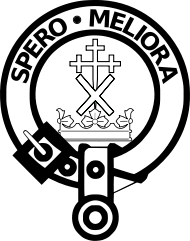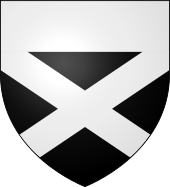- Clan Moffat
-
Clan Moffat Crest badge 
Crest: a crest coronet and issuing there from a cross crosslet fitchee Sable surmounted of a saltire Argent.[1] Motto: Spero meliora.[2] Profile Region Borders District Dumfriesshire Chief

Jean Moffat of that Ilk, [3] Chief of the Name and Arms of Moffat.[3] Seat St Jasual, Wheeler End, Buckinghamshire Clan Moffat is a Lowland Scottish clan.
Contents
History
Origins of the clan
The Moffats are an ancient Borders family who were influential and powerful as far back as the time of Sir William Wallace. The ancestor of the Moffats most likely gave their name to the town of Moffat in Dumfriesshire. The origin of the name itself is thought to be Norse. William de Mont Alto, progenitor of the Movats, married the youngest daughter of Andlaw, who came to Scotland from Norway during the tenth century. Over the years the name softened to Montealt, then Movat, through Movest, eventually settling at Moffat in its modern form. In the twelfth century the family was of sufficient importance to be designated in deeds and records as ‘de Moffet’, showing the family were considered to be principal lairds, or landowners.
In 1268, Nicholas de Moffet was Bishop of Glasgow, and the armorial bearings of the different branches of the family seemed to indicate a connection with the church. Robert the Bruce, as Lord of Annandale, granted four charters of land in the Barony of Westerkirk to the Moffats in 1300. One of these was to Adam Moffat of Knock who was granted ‘the same Barony in Eskdale’. Both he and his brother fought at the Battle of Bannockburn in 1314, along with many Moffat clansmen. They remained the Lairds of Knock until 1609, when the land was sold to the Johnstones. They were also tenants of Midknock for six hundred years, until 1905. In 1336 the king of England granted a safe conduct to William de Moffet and others described as ‘coming as ambassadors from David de Brus’ – in fact, David II, son of Robert the Bruce. In 1337, Walter de Moffet, Archdeacon of Lothian, was appointed ambassador to France.
Wars of Scottish Independence
During the Wars of Scottish Independence the Clan Moffat were supporters of King Robert the Bruce. As a result they received a charter from him for four charters of land in the barony of Westerkirk in the year 1300. The Clan were led by Adam Moffat of Knock at the Battle of Bannockburn in 1314. Their units consisted of heavy cavalry, nobles adorned in plate armour and well equipped picketmen. They were lowlanders and had the resources to equip their men.
16th century
The Clan Moffat had a long feud with the Clan Johnstone who were another Scottish border clan who were raiders and reivers, and conducted long-running feuds with their neighbours. The feud accumulated in 1557 with murder of the Clan Moffat chief, Robert Moffat. The Clan Johnstone then went on to burn the church with the most important members of the Moffat family inside and slaughtered anyone who tried to escape. In one blow the powerful Clan Moffat was almost wiped out. Seventy years later all of the Moffats' lands were passed to the Johnstones due to the Moffats having massive debts.
The modern clan
From at least the mid sixteenth century the clan was without a chief, until 1983 when after many years of research, Francis Moffat was granted the undifferenced Arms of Moffat of that Ilk, and recognised as the hereditary chief of the clan by Lord Lyon King of Arms.[4] In April 1992, the chiefship passed to his daughter, Jean Moffat of that Ilk.[4][3]
Clan profile
Origin of the name
The surname Moffat/Moffatt is a habitational name of Gaelic origin, derived from Moffat in Dumfriesshire.[5] This place-name translated as "the long plain" was derived from two elements: magh ("plain") and fada ("long").[5] The area of Moffat does not resemble a "long plain" at all, so it is thought that "Moffat" was the locals' attempt at saying "Mowat" as the Mowats, Moffats, and Montaltos all share a common progenator and at one time bore identical arms. (Major Francis Moffat of that Ilk, "The Moffats")
Clan chief, crest and motto
- Clan chief: Jean Moffat of that Ilk, Chief of the Name and Arms of Moffat.[3]
- Clansman's Badge: A member of the Clan may wear a Badge consisting of the Crest from the Chief's Arms encircled by a strap and buckle [1]. The Moffat Chief's arms has "a crest coronet and issuing there from a cross crosslet fitchee Sable surmounted of a saltire Argent".[6]
- Clan motto: Spero meliora (translation from Latin: I hope for better things,[7] or I aspire to greater things).[8][9]
Clan tartan
The Moffat family tartan is a very modern tartan, created by Major Francis Moffat of that Ilk, after being recognised as the chief of the clan in 1983.[10] The tartan is heavily based upon the Clan Douglas tartan.[10] According to Major Francis Moffat of that Ilk, in his book, "The Moffats," the colors he selected for the modern tartan (black, silver, and a very small amount of red) were taken from the most ancient arms coats associated with the Moffats, a black rampant lion on a silver field, with red teeth and claws.
See also
Notes
- ^ myclan.com tab: crest and motto
- ^ myclan.com tab: crest and motto
- ^ a b c d Moffat of that Ilk, Chief of Moffat
- ^ a b Clan History Retrieved on 2007-11-18
- ^ a b Moffatt Name Meaning and Origin Retrieved on 2007-11-18
- ^ myclan.com tab: crest and motto
- ^ myclan.com tab: crest and motto
- ^ Clan History Retrieved on 2007-11-18
- ^ Spero Meliora Retrieved on 2007-11-18
- ^ a b Moffat Family Tartan WR1129 Retrieved on 2007-11-18
External links
Scottish clans Clans with chiefs Agnew · Anstruther · Arbuthnott · Arthur · Bannerman · Barclay · Borthwick · Boyd · Boyle · Brodie · Broun · Bruce · Buchan · Burnett · Cameron · Campbell · Carmichael · Carnegie · Cathcart · Charteris · Chattan · Chisholm · Cochrane · Colquhoun · Colville · Cranstoun · Crichton · Cumming · Darroch · Davidson · Dewar · Drummond · Dunbar · Dundas · Durie · Elliot · Elphinstone · Erskine · Farquharson · Fergusson · Forbes · Forsyth · Fraser · Fraser of Lovat · Gayre · Gordon · Graham · Grant · Gregor · Grierson · Guthrie · Haig · Haldane · Hamilton · Hannay · Hay · Henderson · Home · Hope · Hunter · Irvine · Jardine · Johnstone · Keith · Kennedy · Kerr · Kincaid · Lamont · Leask · Lennox · Leslie · Lindsay · Lockhart · Lumsden · Lyon · MacAlister · MacBain · MacDonald · Macdonald of Clanranald · MacDonald of Keppoch · Macdonald of Sleat · MacDonell of Glengarry · MacDougall · Macdowall · MacIntyre · Mackay · Mackenzie · Mackinnon · Mackintosh · Maclachlan · Maclaine of Lochbuie · MacLaren · MacLea (Livingstone) · Maclean · MacLennan · MacLeod · MacLeod of Lewis · MacMillan · Macnab · Macnaghten · MacNeacail · MacNeil · Macpherson · MacTavish · MacThomas · Maitland · Makgill · Malcolm (MacCallum) · Mar · Marjoribanks · Matheson · Menzies · Moffat · Moncreiffe · Montgomery · Morrison · Munro · Murray · Napier · Nesbitt · Nicolson · Ogilvy · Oliphant · Primrose · Ramsay · Rattray · Riddell · Robertson · Rollo · Rose · Ross · Ruthven · Sandilands · Scott · Scrymgeour · Sempill · Shaw · Sinclair · Skene · Spens · Stirling · Strange · Stuart of Bute · Sutherland · Swinton · Trotter · Urquhart · Wallace · Wedderburn · Wemyss · Wood ·
Armigerous clans Abercromby · Abernethy · Adair · Adam · Aikenhead · Ainslie · Aiton · Allardice · Anderson · Armstrong · Arnott · Auchinleck · Baillie · Baird · Balfour · Bannatyne · Baxter · Bell · Belshes · Bethune · Beveridge · Binning · Bissett · Blackadder · Blackstock · Blair · Blane · Blyth · Boswell · Brisbane · Buchanan · Butter · Byres · Cairns · Calder · Caldwell · Callender · Campbell of Breadalbane · Campbell of Cawdor · Carruthers · Cheyne · Chalmers · Clelland · Clephane · Cockburn · Congilton · Craig · Crawford · Crosbie · Cunningham · Dalmahoy · Dalrymple · Dalzell · Dennistoun · Don · Douglas · Duncan · Dunlop · Edmonstone · Fairlie · Falconer · Fenton · Fleming · Fletcher · Forrester · Fotheringham · Fullarton · Galbraith · Galloway · Gardyne · Gartshore · Ged · Gibsone · Gladstains · Glas · Glen · Glendinning · Gray · Gunn · Haliburton · Halkerston · Halket · Hepburn · Heron · Herries · Hogg · Hopkirk · Horsburgh · Houston · Hutton · Inglis · Innes · Kelly · Kinloch · Kinnaird · Kinnear · Kinninmont · Kirkcaldy · Kirkpatrick · Laing · Lammie · Langlands · Learmonth · Little · Logan · Logie · Lundin · Lyle · MacAulay · Macbrayne · MacDuff · MacEwen · MacFarlane · Macfie · Macgillivray · MacInnes · MacIver · Mackie · MacLellan · Macquarrie · Macqueen · Macrae · Masterton · Maule · Maxton · Maxwell · McCorquodale · McCulloch · McKerrell · Meldrum · Melville · Mercer · Middleton · Moncur · Monteith · Monypenny · Mouat · Moubray · Mow · Muir · Murray of Atholl · Nairn · Nevoy · Newlands · Newton · Norvel · Ochterlony · Orrock · Paisley · Paterson · Pennycook · Pentland · Peter · Pitblado · Pitcairn · Pollock · Polwarth · Porterfield · Preston · Pringle · Purves · Rait · Ralston · Renton · Roberton · Rossie · Russell · Rutherford · Schaw · Seton · Skirving · Somerville · Spalding · Spottiswood · Stewart · Stewart of Appin · Strachan · Straiton · Strange · Sydserf · Symmers · Tailyour · Tait · Tennant · Troup · Turnbull · Tweedie · Udny · Vans · Walkinshaw · Wardlaw · Watson · Wauchope · Weir · Whitefoord · Whitelaw · Wishart · Young
Culture and society Scotland · Clan chief · Septs · Clan badge · Clan crest · Clan battles · Tartan · Bagpipes · Clearances · Kilt · Manrent · The Highlands · Battle of Culloden · Highland games · Border Reivers · Scottish heraldry · Scottish surnames
Categories:- Scottish clans
Wikimedia Foundation. 2010.

